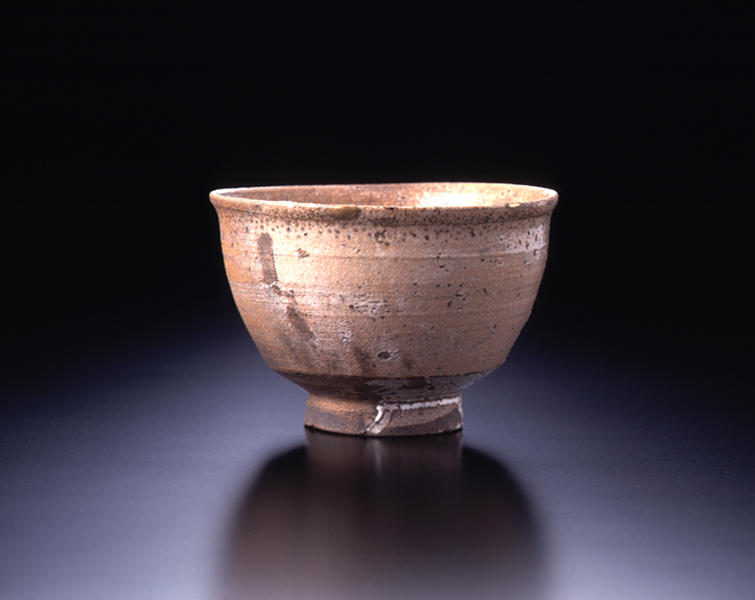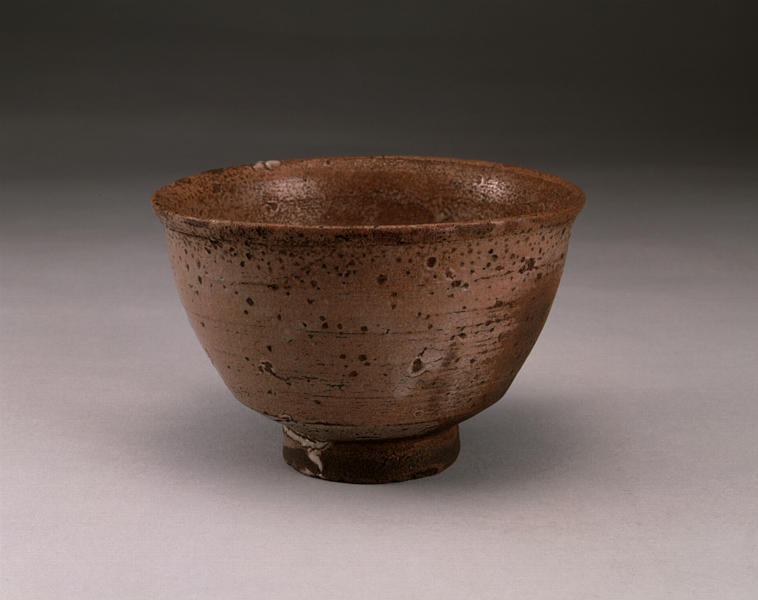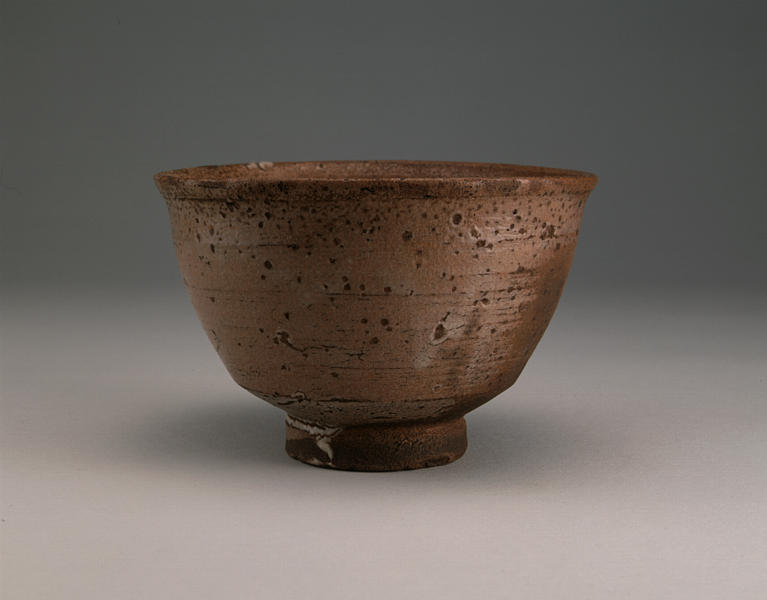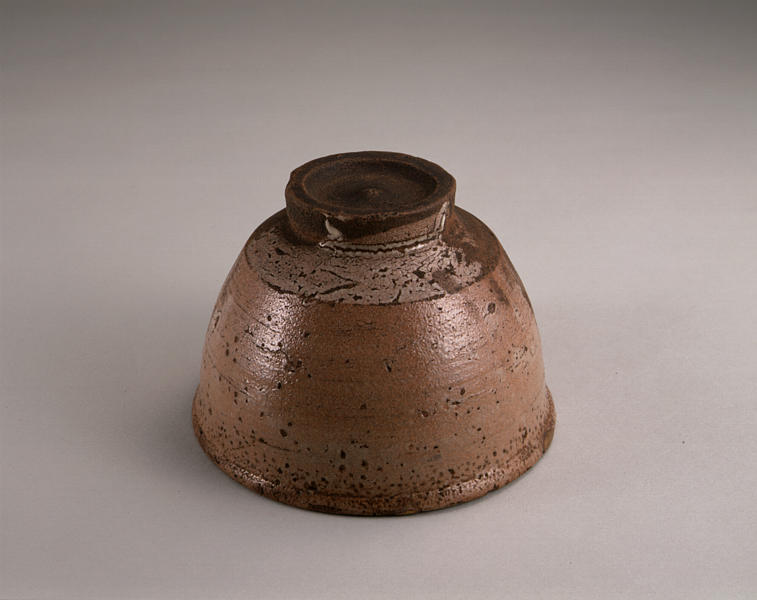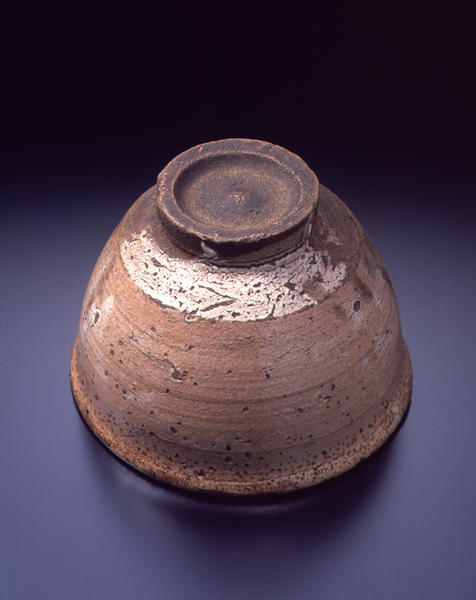奥高麗茶碗 銘 入舟
- 佐賀県・唐津窯
- 桃山時代
- 16c
- 施釉陶製
- H-8.5 D-13
奥高麗とは、桃山時代の古唐津茶碗で、熊川風の古高麗茶碗を写したものである。奥は往古の意とも、朝鮮よりも内陸で産したことからの奥の意ともとれるがはっきりとしない。この茶碗は典型的な奥高麗の姿をしている。しっかりした露胎の高台からは砂気の少ない細かい素地土が見て取れる。器胎にかけられた釉は枇杷色を呈し、ところどころに白く溜まった長石釉と相まって、味わい深い茶碗となっている。箱書は遠州流八代の小堀政優(まさやす)宗中で、「入船」と銘がつけられている。
唐津焼(からつ)
佐賀県西部から長崎県一帯にかけて焼かれた陶器。窯跡は広範囲に広がっています。開窯時期は天正年間とされていますが、大々的に発展したのは豊臣秀吉による文禄・慶長の役(丁酉倭乱)(ていゆうわらん)で朝鮮の陶工たちが日本に連れてこられて以降のことです。桃山時代の作品は特に茶陶に優品が多く、江戸時代前期までその様式は引き継がれました。
瀬戸唐津茶碗
絵唐津水指 銘 十字むしもち
絵唐津筒向付
絵唐津柳文輪花向付
絵唐津矢文向付
奥高麗水指 銘 明月
唐津大皿
本手瀬戸唐津茶碗 銘 雲井
解説(春の玉手箱)
唐津焼は一六世紀末の文禄・慶長の役の後に朝鮮陶工が興したと言われている。肥前一帯(佐賀県と長崎県の一部)で焼かれたが、奥高麗は江戸時代からの呼称で、広義には高麗茶碗を写した唐津焼である。大振りで作為のない豊かな感じのするものが多く、しみじみとした静けさが侘び茶の精神に適ったものであろう。枇杷色をしたものが比較的好まれる傾向があるが、この茶碗は薄紅に融けた釉が美しく、強い口作りと腰の箆取りがその個性を増している。高台も重厚で高く、胴の張りとともに呉器を見るような風格をも感じさせる。
箱の蓋裏に、「暮ぬるる 真帆に行帆を引ませて おのおの帰る 浦々舟人」と遠州流八代小堀宗中(一七八六~一八六七)の箱書がある。風を孕んで張り詰めた帆のような胴と、薄紅の釉が沈んだ色の地肌に溶け込む景色に、夕暮れを映す白帆がそれぞれの港を目指して進む様が浮かぶようである。
Catalogue Entry
Karatsu ware was said to have been established by Korean potters brought to Japan after the Japanese military campaigns on the continent during the Bunroku and Keicho eras at the end of the 16th century. These wares are fired in the Hizen region (a section of present‐day Saga prefecture and Nagasaki prefecture) and the wares that have been known as Oku‐gorai since the Edo period are Karatsu ware works made in the style of Korean Korai ware teabowls. Many of these works are generously, unpretentiously formed, and they have a subdued, quiet nature that is suitable for the austere elegance of wabi tea ceremony aesthetics. While a light orangish yellow color was generally preferred, the light red melted glaze of this bowl is quite beautiful, and the strongly shaped mouth and spatula carved lower body increase its individual flavor. The foot is thick and tall, and this form combined with the swell of the torso gives the bowl a "goki" format sensibility. The inside of the box lid is inscribed with a poem about sailing ships returning at dusk by Kobori Sochu (1786‐1867), the eighth generation head tea master of the Enshu tea school of tea ceremony. The torso of this bowl swells like a sail filled with the wind, and the light red glaze resembles a sail tinged with sunset glow as boats return to their ports as dusk.
